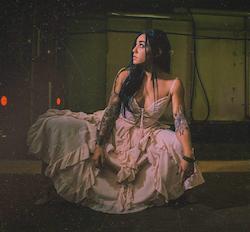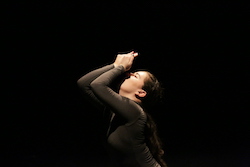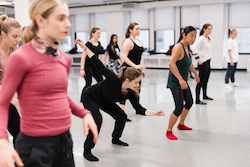Does it matter what we call it? Dance styles, lingo, tradition and innovation

“No one knows what ‘contemporary’, ‘modern’ or ‘jazz’ even is any more.” Have you heard that before? This writer has. She may have even said it herself a few times. It may be an exaggeration, but the fact remains that many dance artists and teachers are blending such forms and therein creating something new of their own. Do we lose the integrity and clarity of classic, codified techniques as a result — and such blending is therefore to be done with care and reservation? On the other hand, is this blending of forms opening up space for fruitful collaboration — and therefore to be encouraged? For those who care about the flourishing of dance art into the future as well as the preservation of its tradition, these seem to be matters not to be taken lightly.
To dig into these questions, Dance Informaspoke with four dance artists: Hana Kozuka, LA-based dancer/choreographer; Bettina Mahoney, founding director of Fortitude Dance Productions and dance educator; Tracie Stanfield, founding director of NYC-based Synthesis Dance; and Taylor McLean Bosch, artistic director of Nitrogen: The Company and NYC/Long Island-based dance educator. Let’s leap right in!

Why this variety of styles? Is there a larger impact happening in the dance world as a result?
Stanfield believes that “fusion of styles (sub styles) is, in one way, a reflection or a response to the world we live in. Our society, more than ever, values individuality, personalization and autonomy. Artists are not constrained by ‘rules’ or methodology of the past.” McLean Bosch’s thought here is similar. “Everyone’s trying to find their voice,” she thinks. Kozuka notes that this proliferation of styles brings “so many more things to fuse together.”
On the other hand, Stanfield describes how we can see this trend as another wave of style/technique proliferation that happened with the growth of Graham, Horton and Limón techniques and repertoire — but with “a main difference being that there is no official, definitive foundational system for each sub style or technique; it is solely dependent on the choreographer/teachers’ values and preferences.” Additionally, this proliferation is happening nowadays in “street, jazz and ballet styles,” Stanfield says. For instance, there’s been a blossoming of classes in sub-styles such as “contemporary jazz”, “contemporary fusion”, “contemporary street”, “contemporary ballet” and “lyrical jazz”.

Yet some teachers identify and promote themselves not by a conventional style they teach but instead by their own movement style/quality and brand. In turn, students can look to teacher names and brands rather than styles when deciding which classes to take — as Kozuka attests is her norm. “It’s hard to put a label on things nowadays!” she says. She points to social media as a driver of this trend to build one’s brand. As a teacher, McLean Bosch believes that she has a unique style and aesthetic, yet will say that she’s a “contemporary” teacher if that’s what employers are looking for.
There’s a tension between artist’s mode of branding and those of dance-based businesses, however; Mahoney describes how she has to name certain teachers’ classes for her conventions, even if they don’t like their style being “categorized”. “I have a business, and I have to advertise,” she asserts. Validating that point, McLean Bosch points to conventions losing business from not offering “contemporary” classes. At the same time, competitions have classified her pieces as “modern” — when she believes her work is more “contemporary” than “modern”.
Is it a problem? Is it a good thing? Is it both? What’s important to keep in mind, in terms of approaches in pedagogy, choreography, branding?
Mahoney gets concerned when it comes to dance students having a base of codified technique or not; “you can’t go ‘off-book’ if you don’t have the book in the first place,” she asserts. Part of this important instilling of conventional dance styles in young students is teaching dance history — where these forms came from within overall historical context. “Then students can know that contemporary grew out of postmodern, and postmodern out of modern, for example,” Mahoney affirms. As far as she sees it, respect for and mastery of such forms — and their historical legacy — makes for much stronger choreography, performance, pedagogy and more. As the old saying goes, you have to know the “rules” before you can “break them”.
Kozuka and McLean Bosch ultimately see this trend of styles blending and proliferating as a good thing, something that can allow artists to find their truest creative voices and make wonderful work. Kozuka thinks that rather than feel as if we must put things in “boxes”, it’s in our power to make new boxes. “If [new styles] stand the test of time, then they’ll stick — or they won’t,” she thinks. “It’s just going to happen — new styles will emerge, and older genres will go stale,” McLean Bosch states.
Stanfield validates the finding of one’s own movement style; “even no rule is a rule.” She applauds the space for creativity and freedom, and points out that innovation always brings fear of change (like “grumblings from the [ubitquity] of cell phones.”). In the end, Mahoney believes that dance artists bring their own movement history, from the unique qualities of teachers and choreographers they’ve studied with and danced for. Kozuka also underscores this point. Embodying, and from there passing on, stylistic and technical legacy would seem to be something to encourage — as it’s how the dance field has grown to be what it is.

How does the dance world make the most of this trend?
Stanfield does underline the challenge for dancers that all of this can create — having to train in “all styles”. “When everything is important, ultimately nothing is important.” she believes. Thus, deeper conversations about what’s feasible and accessible for dancers would seem necessary. Regarding tensions between dance teaching artists and business owners, such as those McLean Bosch and Mahoney described, perhaps such further dialogue could help there, too. Both parties could express their needs and desires, and finding common ground could bring some mutually agreeable consensus.
Regarding Mahoney’s concerns on dance artists starting from a foundation of codified techniques — technical mastery and deep contextual knowledge thereof — dance educators can frame their curricula around first instilling that foundation in their students, then guiding them to branch out to something more of their own. For Kozuka, navigating these dynamics of stylistic identity is up to each artist to approach with their best judgement, highest integrity, and full personal authenticity. That’ll multiply outward to create a dance world that does the same.
Stanfield believes that “dancers are drawn to work that resonates with them…we gravitate to the experiences and styles that nourish and challenge us.” Labels aren’t necessarily as meaningful for us as they are for other types of people, and we can bring flexible thinking to various situations. With good judgement, integrity, authenticity, and flexible thinking, we can navigate tricky dynamics — even those as tricky as stylistic identity, personal dance artist branding, tradition versus individuality, and the like. Let’s do this!
By Kathryn Boland of Dance Informa.
The post Does it matter what we call it? Dance styles, lingo, tradition and innovation appeared first on Dance Informa Magazine.
